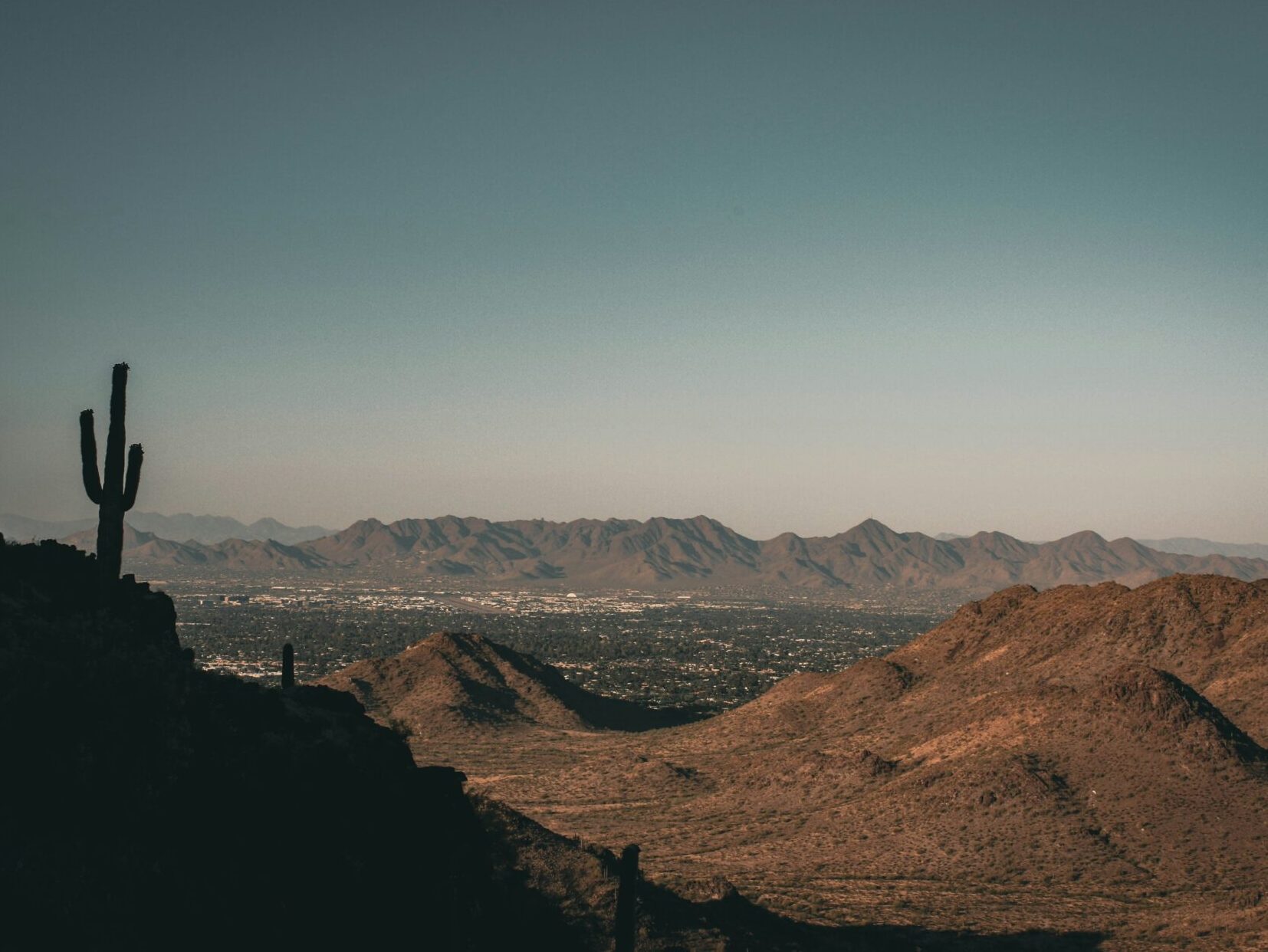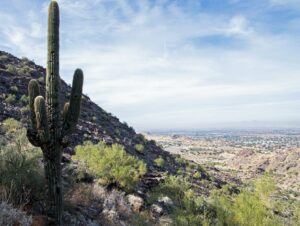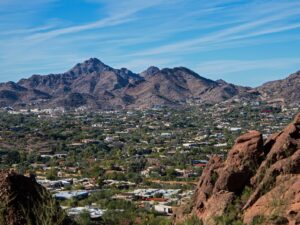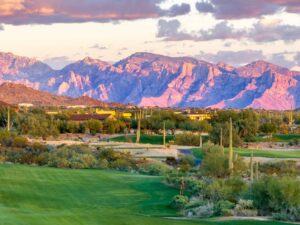Relocating to Phoenix means embracing a unique desert environment that differs significantly from many other parts of the United States. While the allure of year-round sunshine is strong, successfully adapting to desert living requires understanding its distinct characteristics, from the extreme heat to the native wildlife and the importance of water conservation. This guide provides essential tips for newcomers to thrive in Phoenix’s arid climate and adapt to living in the Desert.
Understanding Phoenix’s Unique Climate
Phoenix experiences an arid climate characterized by hot, dry summers, mild winters, and distinct seasonal phenomena.
Living in the Desert: Embracing the Environment
Temperature Extremes
- Summer (May-September): Daily highs consistently exceed 100°F (38°C), often reaching 115°F (46°C) or higher. Nights remain warm. Humidity is generally very low, though “monsoon humidity” can occur.
- Winter (November-February): Mild and pleasant, with daytime temperatures ranging from 60°F-75°F (15°C-24°C). Nights can drop to 40s°F (4°C) or occasionally lower.
- Spring & Fall (March-April, October): Characterized by warm, comfortable days and cool evenings, often considered the most enjoyable seasons.
Adaptation: Always check daily temperatures, even for short outdoor excursions. Dress in layers during cooler months, and prioritize heat-safe attire in summer. For in-depth summer survival, refer to The Ultimate Guide to Surviving Summer in Phoenix as a Newcomer
Low Humidity & Sun Intensity
- Dryness: The desert air is consistently dry, leading to rapid evaporation of moisture from skin and eyes.
- Sun Protection: The sun’s intensity is high year-round. Daily use of broad-spectrum sunscreen (SPF 30+), wide-brimmed hats, sunglasses, and protective clothing is crucial to prevent sunburn and long-term skin damage.
- Personal Hydration: Beyond just summer, consistent hydration with water is vital year-round due to the persistent dryness.
Monsoon Season & Dust Storms
- Monsoon (July-September): Phoenix experiences a distinct monsoon season with increased humidity and the potential for severe thunderstorms, heavy rainfall (often localized), strong winds, and flash flooding.
- Haboobs: Large dust storms, known as haboobs, are common during monsoon season. These walls of dust can significantly reduce visibility and pose driving hazards. If caught in a haboob, pull off the road and turn off your lights.
- Staying Informed: Monitor local weather forecasts, especially during summer, via sources like National Weather Service Phoenix.
Home & Property Adaptations
Desert living influences home design, landscaping, and maintenance.
Water Conservation & Xeriscaping Living in the Desert
Water is a precious resource in the desert. While living in the desert, water-efficient practices is both environmentally responsible and cost-effective.
- Xeriscaping: Prioritize drought-tolerant landscaping (xeriscaping) using native or desert-adapted plants. This significantly reduces water usage compared to traditional lawns. Many local nurseries specialize in desert flora. Learn more about water conservation through the City of Phoenix Water Services Department.
- Efficient Irrigation: Install drip irrigation systems for plants, which deliver water directly to the roots, minimizing evaporation. Water during cooler, non-windy hours (early morning) to maximize absorption.
- Indoor Conservation: Fix leaks promptly, use low-flow fixtures, and run dishwashers/washing machines only when full.
Home Cooling & Maintenance
Your home’s infrastructure plays a vital role in comfort and energy efficiency.
- HVAC System: Ensure your air conditioning system is regularly serviced (at least annually) and filters are changed monthly during peak use. A well-maintained AC is crucial.
- Window Treatments: Install energy-efficient windows, solar screens, or high-quality blinds/curtains to block intense sun and insulate.
- Roofing: Desert roofs can take a beating from the sun. Regular inspections and maintenance are advised to prevent leaks and maintain insulation effectiveness.
- Insulation: Ensure adequate attic and wall insulation to keep cool air in and hot air out.
Pest Control & Wildlife Awareness
The desert is home to various creatures, some of which may seek refuge in or around your home.
- Common Pests: Scorpions, spiders (including black widows and brown recluses), ants, and cockroaches are common. Regular pest control services are often a necessity.
- Wildlife Encounters: Be aware of larger wildlife such as rattlesnakes, javelina, and coyotes.
- Rattlesnakes: Most active in warmer months. Never approach. If encountered, slowly back away. Consider snake-proof fencing around yards. If hiking, use proper footwear and watch where you step.
- Javelina & Coyotes: Tend to forage in residential areas. Do not feed them. Secure pet food and garbage. Keep pets supervised, especially smaller dogs. For pet safety, refer to Internal Link: Pet-Friendly Phoenix: Parks, Services, and More for Your Furry Friends.
- Resources: The Arizona Game and Fish Department provides excellent resources on living with Arizona wildlife.
Personal Well-being & Lifestyle Adjustments
Adapting to desert living also involves personal habits and health considerations.
Living in the Desert – Take care of your skin
The dry climate can be harsh on skin.
- Moisturize: Use hydrating lotions and creams regularly.
- Sun Protection: Beyond sunscreen, protective clothing (long sleeves/pants, wide-brimmed hats) is your best defense against UV radiation, even in winter.
Respiratory Health & Allergies
Dust and desert flora can impact respiratory health.
- Dust & Allergens: Dust storms (haboobs) and pollen from desert plants (e.g., ragweed, olive trees, mesquite) can trigger allergies or respiratory issues.
- Mitigation: Keep windows closed during high pollen counts or dusty conditions. Use HEPA filters in your home’s HVAC system and vacuum cleaner. Consult local allergy reports via sources like American Academy of Allergy, Asthma & Immunology (AAAAI) Phoenix Pollen Count if you experience symptoms.
Adjusting Outdoor Activities
Your recreational schedule will likely shift.
- Timing: During hot months, outdoor exercise and prolonged exposure should be limited to very early mornings or late evenings. Many locals treat summer as an “indoor season” for activities.
- Gear: Invest in lightweight, moisture-wicking clothing, wide-brimmed hats, and reliable water carriers.
- Hiking: Avoid strenuous daytime hikes in summer. Always carry more water than you think you need. For more details on safe outdoor exploration, see Internal Link: Outdoor Adventures Near Phoenix: Hiking, Biking, and Water Sports.
Living in the Desert is a continuous process that involves respect for the environment and proactive planning. By embracing water conservation, understanding local climate patterns, being aware of wildlife, and adjusting daily routines, newcomers can not only survive but truly thrive in this vibrant desert metropolis.
Moving to Phoenix? Request your FREE Phoenix Relocation Guide!




